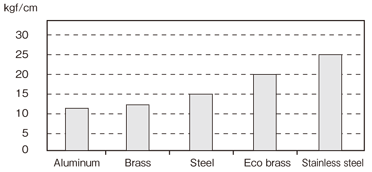
Chemical components
| Eco brass |
Chemical components(wt%) |
| Cu |
Si |
Pb |
P |
Sn |
Fe |
Ni |
Mn |
Al |
Zn |
| 73.0-78.0 |
2.7-3.4 |
≦0.1 |
0.04-0.20 |
- |
- |
- |
- |
- |
Remaining part |
Eco brass is a brass alloy that adds silicon to copper and zinc. While lead-free brass developed in the US is mainly
produced by adding a heavy metal similar to lead such as bismuth, eco brass does not contain any heavy metals.
(Cadmium content 0.001 or less)
Physical properties
| Item |
Unit |
|
| Melting point |
℃ |
880 |
| Density |
 /cm2 /cm2 |
8.3 |
| Thermal conductivity |
W/M/K |
38 |
| Conductivity |
%IACS |
8 |
| Linear expansion coefficient |
×10-6/℃ |
20 |
| Vertical modulus of elasticity |
MPa |
1.05×105 |
Mechanical properties
| Item |
Unit |
|
| Cross-sectional hardness HRB/HV5 |
- |
89/180 |
| Tensile strength |
MPa |
670 |
| Elongation |
% |
32 |
| Yield strength |
MPa |
450 |
Products using eco brass:
| Eco brass spacer |
|
Eco brass features
| (1) Ecological (lead-free) |
Compliant with lead restrictions and with environmental regulations |
|
|
| (2) High strength (same as stainless steel) |
Equivalent strength to stainless steel |
→ |
Possible to reduce costs by replacing stainless steel |
| |
Stronger and better corrosion resistance than steel |
→ |
Quality can be improved by replacing steel |
| (3) Same dezincification corrosion resistance as BC6 and excellent stress corrosion cracking resistance. |
Mechanical strength comparison
| Material |
Cross-sectional hardness |
Tensile strength |
Elongation |
Yield strength |
| HRB |
HV5 |
N/mm2 |
% |
N/mm2 |
| Eco brass |
89 |
180 |
670 |
32 |
450 |
| C3604 |
67 |
120 |
420 |
34 |
240 |
| SUS304 |
90 |
195 |
600 |
55 |
390 |
| SUS303 |
85 |
175 |
600 |
56 |
310 |
| SUM23L |
87 |
180 |
520 |
19 |
470 |
Eco brass is 1.4 times stronger than C3604 and is as strong as typical stainless steels SUS304 and SUS303.
Numerical values are for φ8 (typical value).
Breaking torque-M3-Comparison by material
 |
Note: The numeric values above are typical values. They are not standard values.
